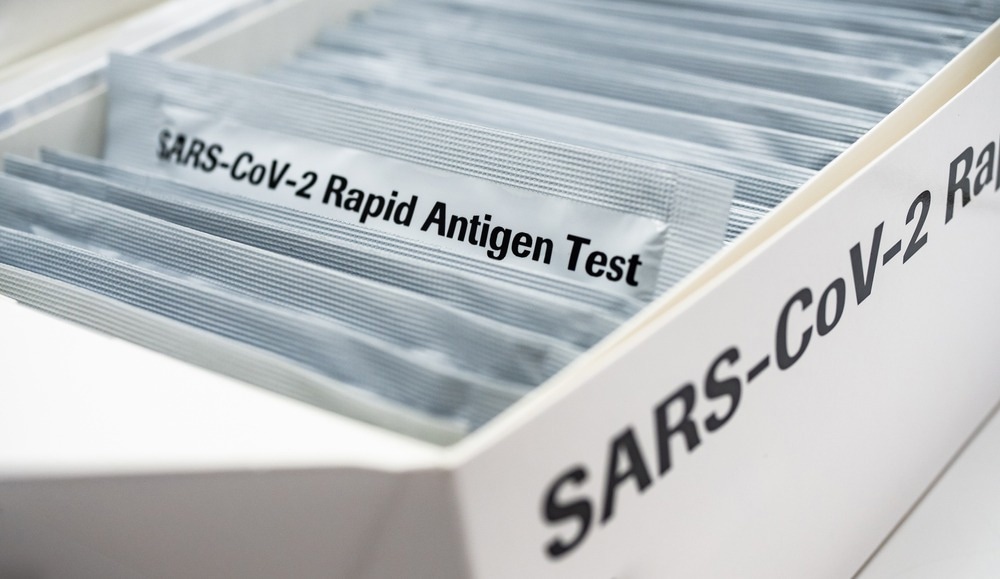In a recent study posted to the medRxiv* preprint server, researchers developed a high-throughput, rapid antigen severe acute respiratory syndrome coronavirus 2 (SARS-CoV-2) spike protein detection test using allonamers, a new type of aptamers that carry out allosteric regulation instead of catalytic activity.
 Study: Development of Q-LAAD, an allonamer-based antigen test for the rapid detection of SARS-CoV-2. Image Credit: Marek Duransky/Shutterstock
Study: Development of Q-LAAD, an allonamer-based antigen test for the rapid detection of SARS-CoV-2. Image Credit: Marek Duransky/Shutterstock

 *Important notice: medRxiv publishes preliminary scientific reports that are not peer-reviewed and, therefore, should not be regarded as conclusive, guide clinical practice/health-related behavior, or treated as established information.
*Important notice: medRxiv publishes preliminary scientific reports that are not peer-reviewed and, therefore, should not be regarded as conclusive, guide clinical practice/health-related behavior, or treated as established information.
Background
Since the onset of the coronavirus disease 2019 (COVID-19) pandemic, there has been an impetus to develop more efficient and accurate SARS-CoV-2 detection tests. The standard detection method so far has been the quantitative reverse transcriptase polymerase chain reaction (RT-qPCR) method, which detects the SARS-CoV-2 ribonucleic acid (RNA) in swab samples from the respiratory tract. It requires trained staff and a laboratory setup for testing and can result in false positives and false negatives due to cross-binding of primers with non-specific regions and mutations in the primer target regions, respectively.
Enzyme-linked immunosorbent assay (ELISA) based tests target the immunoglobulin M (IgM) and G (IgG) antibody responses instead of the SARS-CoV-2 RNA but can give inaccurate results due to insufficient IgM and IgG levels in the early stages of the infection. This makes ELISA-based tests unsuitable for early detection of SARS-CoV-2.
Antigen-detecting rapid diagnostic tests (Ag-RDTs) target viral spike and nucleocapsid proteins in the respiratory tract and are a more suitable option for early detection of COVID-19. However, their dependence on highly specific monoclonal antibodies limits their widespread usage.
Nucleic acid aptamers, with their high sensitivity and binding affinity, can be fused with catalytic RNA or deoxyribonucleic acid (DNA) to form riboswitches or deoxyriboswitches, which can be used as a diagnostic tool.
About the study
In the present study, a team of researchers developed a new class of aptamers known as allonamers, which are allosteric nucleic acid repeats or mers that function like riboswitches or deoxyriboswitches, but with allosteric activity instead of a catalytic mechanism. The allonamers were used to create a high-throughput rapid antigen test called Quantum-Logic Aptamer Analyte Detection (Q-LAAD) to detect the SARS-CoV-2 spike protein.
A DNA allonamer was produced using the systematic evolution of ligands by exponential enrichment (SELEX). This allonamer consisted of two binding domains with a linker region. The binding of the SARS-CoV-2 spike protein to one domain would result in a conformational change in the other binding domain, allowing it to connect to a fluorescent reporter molecule.
The allonamer’s specificity to the SARS-CoV-2 spike protein and its ability to bind to spike proteins of different SARS-CoV-2 variants were tested using immunofluorescence assays. Q-LAAD was validated using nasal swabs from symptomatic potential COVID-19 patients. The sensitivity and specificity of Q-LAAD were compared against those of the RT-qPCR method.
Results
The results showed that in in vitro assays, the allonamer-based Q-LAAD test could detect SARS-CoV-2 spike protein from anterior nasal swabs. The sensitivity and specificity were 97% and 100%, respectively, much greater than the respective 80% and 97% minimum performance requirements established by the World Health Organization (WHO) for the recommended use of Ag-RDTs.
When Q-LAAD was tested against the alpha, beta, gamma, and delta SARS-CoV-2 variants, the fluorescence signals from detecting gamma and delta spike proteins were significantly higher than the nucleocapsid control, while the signals from binding to alpha and beta spike proteins showed a five-fold change, although it was not significant.
The assay was not cross-reactive to any of the 28 common respiratory pathogens or 19 endogenous substances tested in the study. However, other substances, such as purified mucin protein showed some cross-reactivity at 0.5% weight to volume, indicating that the sensitivity of Q-LAAD could decrease if swab samples contained large quantities of mucus. Ingredients of commonly used upper-respiratory infection treatments were also cross-reactive with the assay.
Conclusions
To conclude, the study presented Q-LAAD, a novel allonamer-based rapid antigen test, which showed high sensitivity and specificity to very low levels of SARS-CoV-2 spike protein. The Q-LAAD assay effectively detected most SARS-CoV-2 variants of concern and required small quantities of readily available reagents.
Furthermore, the authors believe that the SELEX process allows the allonamers to be easily modified or updated to bind to spike proteins of future emergent variants and other targets, such as nucleocapsid proteins to develop multi-target assays. The assay requires only a 96-well plate setup and a fluorescence plate reader, which makes the Q-LAAD test time- and cost-efficient.
According to the authors, Q-LAAD combines the sensitivity of PCR-based tests and the speed and simplicity of antigen tests. The adaptability, low detection limit, and cost-effective high-throughput abilities of Q-LAAD could make it an efficient and dynamic tool in the early detection of SARS-CoV-2.

 *Important notice: medRxiv publishes preliminary scientific reports that are not peer-reviewed and, therefore, should not be regarded as conclusive, guide clinical practice/health-related behavior, or treated as established information.
*Important notice: medRxiv publishes preliminary scientific reports that are not peer-reviewed and, therefore, should not be regarded as conclusive, guide clinical practice/health-related behavior, or treated as established information.